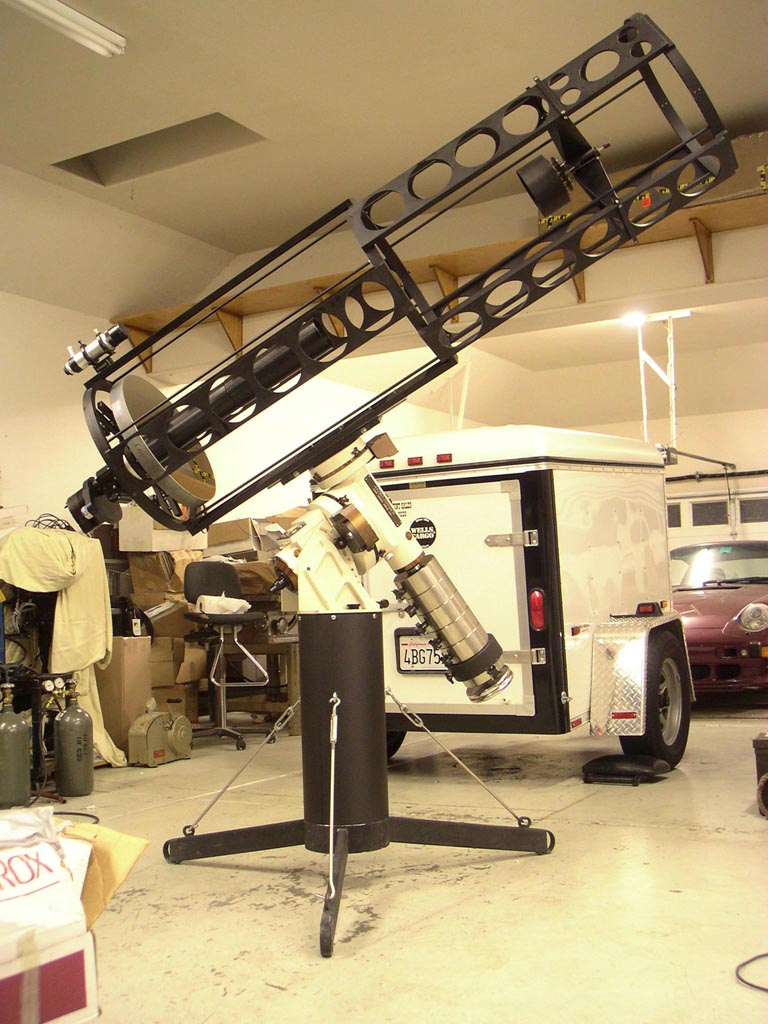
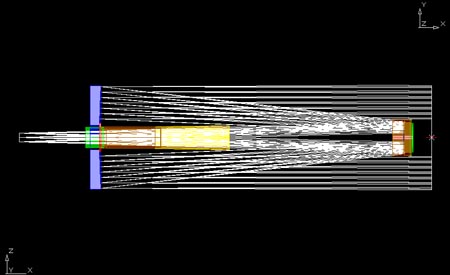


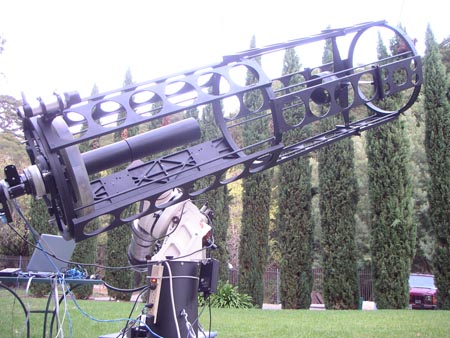
During the summer of 2003, I was impressed with images I had seen which were captured using large-aperture cassegrain telescopes. I had been using a C14 for about two years at the time, but was interested in a larger aperture telescope with a longer focal length to better image smaller sized galaxies and nebulae. I had seen the CN212 convertible Cass/Newt made by Takahashi, so I decided that I would build a convertible telescope that was primarily a Cassegrain and as a backup would be a Newtonian.
The frame is the CPT18 (compact precision telescope) sold by Resource International, which was designed for a newtonian configuration.
The project commenced in the fall of 2003 with the ordering of the frame from Resource International.
Collapsed (click to enlarge) Extended (click to enlarge)
The frame was received in March of 2004 and it fits nicely in the backseat of my wife's car:
click to enlarge
Very soon after ordering the frame I contacted Optical Mechanics, the maker of the very fine Torus Pro-Spec mirrors. I did this on the suggestion of Russ Croman, one of the finest amateur imagers I know. Russ had the highest regard for the mirror in his 18" Obsession dobsonian telescope. OMI makes mirrors for Obsession and Russ has been very pleased with his.
James Mulherin, the president and master optician at OMI, and I discussed the prospect of making a convertible Classical Cassegrain/Newtonian. In early February 2004, we agreed on the following target specifications
Cassegrain Configuration (preferred configuration):
18" (457mm) f/12.6, F=226.8 inches (5760mm)
Newtonian Configuration (alternate configuration)
18" (457mm) f/4.2, F=75.2 inches (1920mm)
Back focus: 14" from front surface of primary mirror
Central obstruction: 6"
James developed the following "prescription" for the Cassegrain
Mirror Material: Fine anneal Corning Pyrex.
Primary Mirror: 18” diameter F/4.2 paraboloid on nominal 2” thick substrate.
Primary mirror clear aperture: 17.8” (Mirror diameter minus safety edge bevel.)
Secondary mirror: 6” diameter hyperboloid (3x amplification) on 1” thick substrate
Secondary mirror clear aperture: 5.66”
Focal length at Cassegrain focus: 226.8” (F/12.6)
Back focus: 14” nominal
Secondary and baffling to be designed to provide 1.66 (.4 degree) diameter fully illuminated field of view.
Wavefront quality at prime focus: <.2 wave P-V, <.05 wave RMS, >.97 Strehl ratio.
Wavefront quality at Cassegrain focus: <.25 wave P-V, <.07 wave RMS, >.90 Strehl ratio. All measurements take on the wavefront in auto-collimation at 633 nm. Interferometric certification to be supplied with optics set.
SURFACE
DATA SUMMARY:
Surface
Radius Separation Glass
Diameter Conic
Pri
-151.2
-53.20
Mirror 17.8
-1
Sec -67.20 67.20 Mirror 5.66 -4
Cassegrain ray tracing results:
Field
Type: Angle in degrees
# Y-Value
Weight
1 0.000000 1.000000
2
0.050000
1.000000
3
0.100000
1.000000
4
0.150000
1.000000
5 0.200000 1.000000
click to enlarge
click to enlarge
click to enlarge
click to enlarge
The following ray tracings are for the Newtonian (alternate) configuration:
click to enlarge
click to enlarge
click to enlarge
The next task was modifying the frame to support the Cassegrain configuration in addition to its original Newtonian configuration.
Needing attention was the spider, secondary mirror support, baffles and instrument support. For the instrument interface, I chose a C14 type thread so that I can easily switch my instruments from my C14 to my CC18. Once again OMI came through, this time with wonderful machined parts:
click to enlarge
click to enlarge
click to enlarge
after the drawings were approved OMI went to work machining these parts, modifying some of the parts made by Resource International (the black anodized parts in the photos below) and making new ones (the shiny parts) where needed.
click to enlarge
click to enlarge
click to enlarge
click to enlarge
click to enlarge
click to enlarge
Once the parts were anodized and received I assembled the unit
click to enlarge
click to enlarge
click to enlarge
click to enlarge
Optical Mechanics ground, figured, polished the optics and tested them as shown below.
Mirror set on testing jig (main mirror is on left side, autocollimation flat is seen on right side of jig
Autocollimation Flat View with secondary mirror visible
Main Mirror on test jig
Rear support of main mirror on test jig with secondary mirror and autocollimation flat visible in background
Looking through baffle hole in main mirror at secondary and autocollimation flat
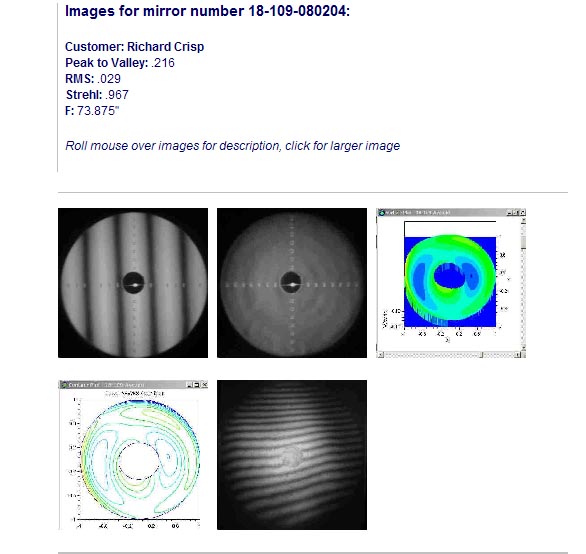
Summary of Main Mirror Test Results
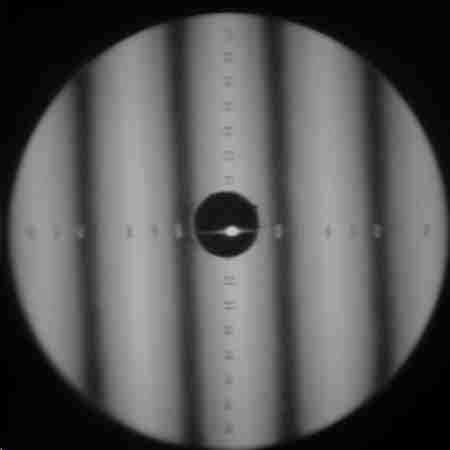
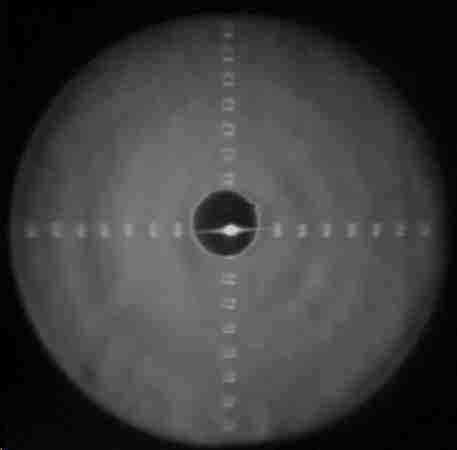
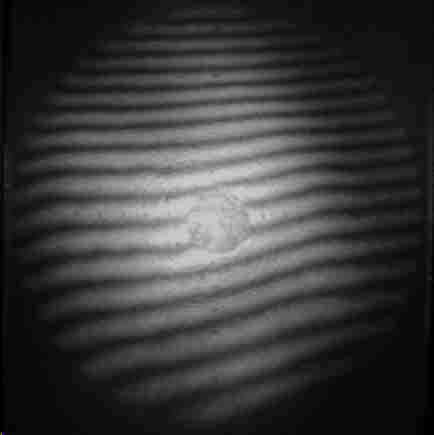
Main Mirror
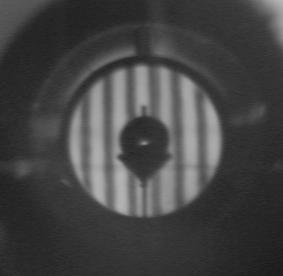
Cassegrain Mode Autocollimation Testing Result A
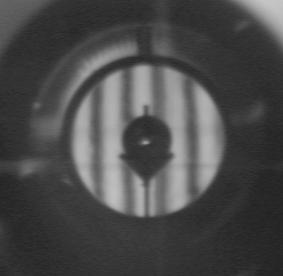
Cassegrain Mode Autocollimation Testing Result B
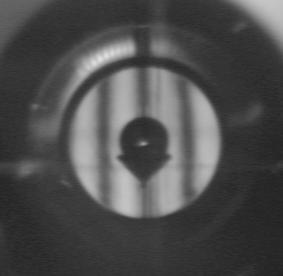
Cassegrain Mode Autocollimation Testing Result C
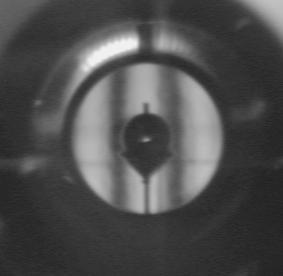
Cassegrain Mode Autocollimation Testing Result D
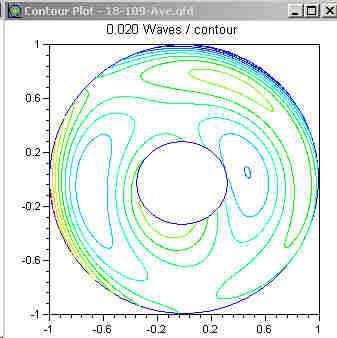
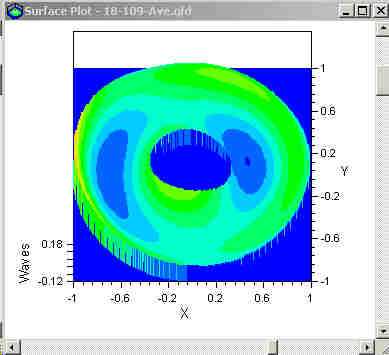
Once the optics were received from OMI, it was time to assemble, balance, align, collimate and begin testing
Mounted on the AP1200GTO mount. Note the number of counterweights
I mounted the trusty and so hard to find "ASTRO" upright finder.
The thickness of the primary is readily apparent in this shot.
The collimation and focus adjustments for the spider are visible here
The business end
Oct 18, 2004
The first day I was ready to do terrestrial testing, it was raining as so often happens when testing new optics, so I shot some images from my garage through an open window with no screen. I had a very limited view of the backyard but managed to find some plants about 200 feet away to image. Unfortunately in addition to rain, there was a lot of wind blowing so it was very difficult to get a still shot, the plants kept moving around.
Still the images are useful: the image can be focused, there are no hot spots and there's no vignetting.
1 x 0.1 second, ST10XME, 2x2 binning, Schuler 9nm Halpha filter
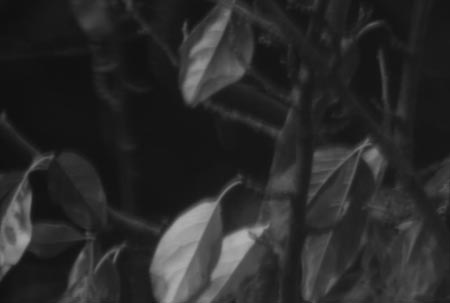
10 x 0.1sec for R, G, B filters
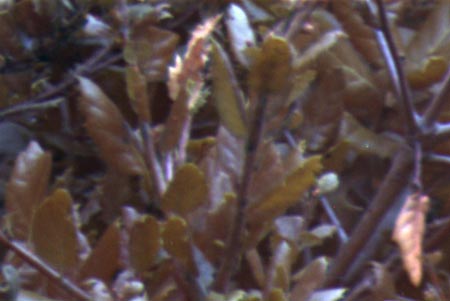
Click to enlarge
click to enlarge
click to enlarge, click here for highest resolution
10 x 3 min, R, G 7 x3 min B
IMG6303E Camera, AO7
ST7E guider
No flats
click to enlarge, click here for highest resolution
10 x 15 sec, R, G, B, 10 x 30 sec Halpha
Red + Halpha -> Red Channel
Halpha = Lum Channel
IMG6303E Camera, AO7
ST7E guider
No flats